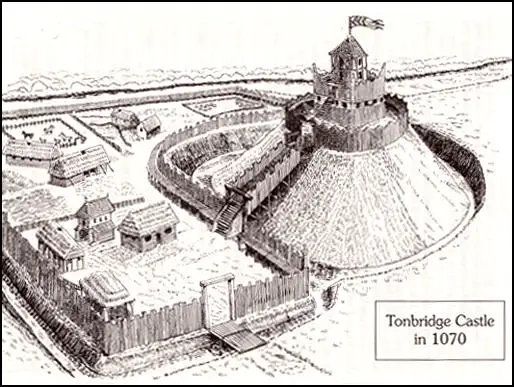Norman Castles
William the Conqueror built his first castle at Hastings soon after the Normans arrived in 1066. They looked for sites that provided natural obstacles to an enemy, such as a steep hill or a large expanse of water. It was also be important to have good views of the surrounding countryside.
The Norman conquerors realised that with only 10,000 soldiers in England, they would be at a disadvantage if the one and a half million Anglo-Saxons decided to rebel against them. To defend the territory they had conquered, the Normans began building castles all over England. It is estimated they built 50 castles in the first 20 years after the invasion. (1)
Richard Fitz Gilbert, like the other Norman leaders, looked for sites that provided natural defences such as a steep hill or a large expanse of water. To protect his estates in Kent, Richard built a castle at Tonbridge, by the side of the River Medway. The castle, built in the motte-and-bailey style, was made of wood. Local peasants were forced to dig a deep circular ditch. The displaced earth was then thrown into the centre to create a high mound called a 'motte'. By the time they finished, the motte was 18 metres (60 feet) high. Richard's labourers erected a wooden tower on top of the mound. The tower provided accommodation and a look-out point.

A courtyard, known as the bailey, was built next to the mound. The bailey was linked to the mound by a bridge. If an attacking force managed to get inside the bailey, the bridge could be pulled up to keep the invaders away from the people in the tower. The bailey was enclosed by a fence of wooden stakes called a palisade. The enclosed area would provide a site for houses and stables. Richard's labourers also built a bridge across the ditch that surrounded the castle. When filled with water, this ditch became known as a moat. The River Medway provided a constant supply of water for the moat at Tonbridge. (2)
Normans built castles at major centres all over the country. The first ones were built by local people. The Anglo-Saxon Chronicle complained that the peasants were "sorely burdened the unhappy people of the country with forced labour on the castles... and when the castles were made they filled them with devils and wicked men." (3)
These castles were later rebuilt in stone. As Trevor Rowley has pointed out: "To many Englishmen the physical impact of the Conquest was manifested in the great feats of construction - the churches and the cathedrals, and, most of all, the castles. It was the latter which provided tangible and irrefutable evidence of Norman political and military domination." (4)
Primary Sources
(1) Anglo-Saxon Chronicle, Version E, entry of 1137
And they filled the whole land with these castles. They burdened the unhappy people of the country with forced labour on the castles. And when the castles were made they filled them with wicked men.
(2) Water of Terouanne describing the motte and bailey castles built by William the Conqueror (c. 1100)
They make a mound of earth as high as they can, and encircle it with a ditch as broad and deep as possible. They surround the upper edge of the mound... with a palisade of squared timbers firmly fixed together... Within they build their house, a stronghold that commands the whole... The gate can only be reached by crossing a bridge, which starts from the outer edge of the ditch.
Student Activities
The Battle of Hastings (Answer Commentary)
William the Conqueror (Answer Commentary)
The Feudal System (Answer Commentary)
The Domesday Survey (Answer Commentary)
Thomas Becket and Henry II (Answer Commentary)
Why was Thomas Becket Murdered? (Answer Commentary)
Illuminated Manuscripts in the Middle Ages (Answer Commentary)
